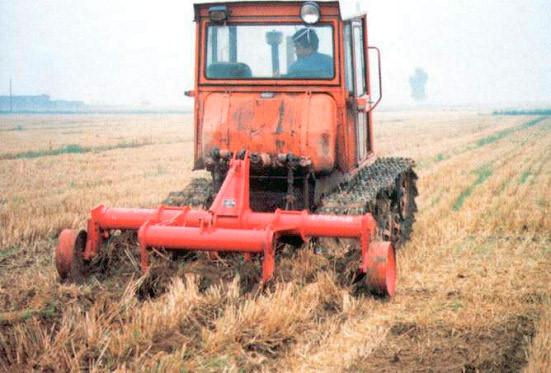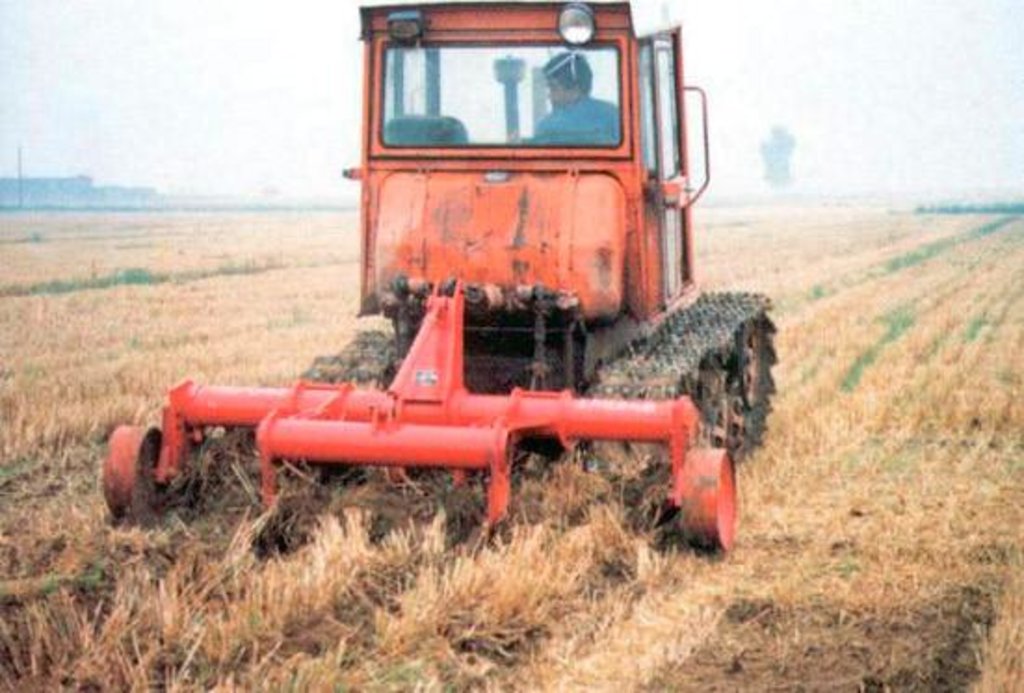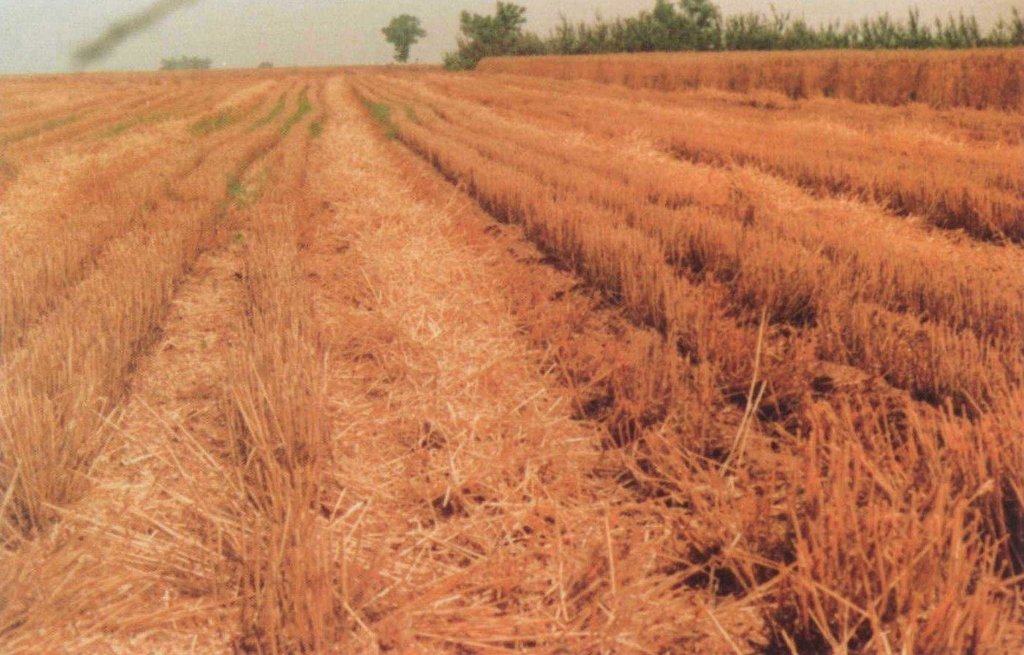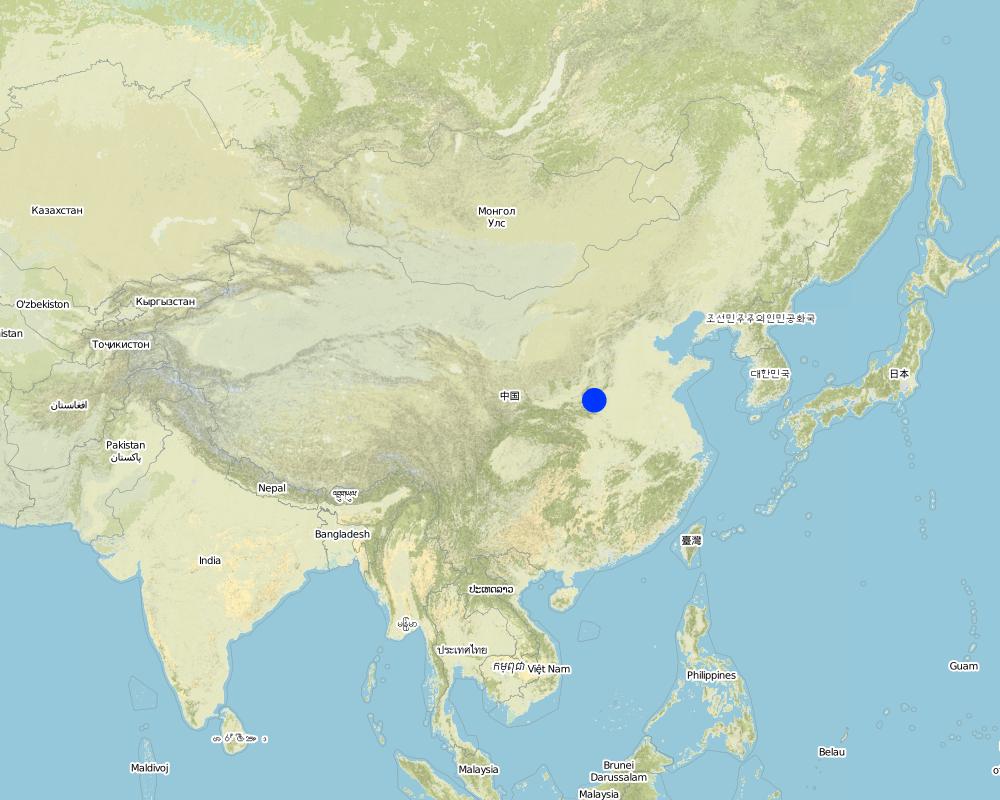Subsoiling [الصين]
- تاريخ الإنشاء:
- تحديث:
- جامع المعلومات: Zhanguo Bai
- المحرر: –
- المُراجع: Laura Ebneter
approaches_2401 - الصين
عرض الأقسام
توسيع الكل طي الكل1. معلومات عامة
1.2 تفاصيل الاتصال بالأشخاص الرئيسيين لمصدر المعلومات والمؤسسات المعنية بتقييم وتوثيق النهج
اسم المؤسسة (المؤسسات) التي سهلت توثيق/تقييم النهج (إذا كان ذلك على صلة)
Institute of Agricultural Resources and Regional Planning of Chinese Academy of Agricultural Sciences (CAAS) - الصين1.3 الشروط المتعلقة باستخدام البيانات الموثقة من خلال WOCAT
يوافق جامع المعلومات والشخص (لاشخاص) الرئيسي لمصدر المعلومات على الشروط المتعلقة باستخدام البيانات الموثقة من خلال WOCAT:
نعم
1.4 المراجع الخاصة باستبيان(استبيانات) تقنيات الإدارة المستدامة للأراضي
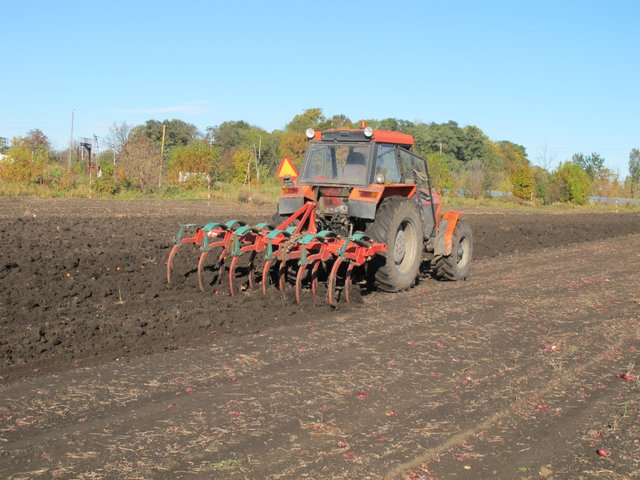
Subsoiling [بولندا]
Subsoiling is defined as tillage below a depth of about 35-40 cm which doesn't invert the soil. It breaks up compacted layers to improve rooting and infiltration. Subsoiling is not needed on light soils, because these are rarely at risk of compaction.
- جامع المعلومات: Tymoteusz Bolewski
2. وصف نهج الإدارة المستدامة للأراضي
2.1 وصف موجز للنهج
Subsoiling with mulching is one of the conservative tillage using subsoiling plough to loose subsoils with surface soil undisturbed.
2.2 وصف تفصيلي للنهج
وصف تفصيلي للنهج:
Sustainable agriculture in the dry and semidry region in the North China, especially o the slope farmland is searching always based on the ecological balance. Conservative tillage such as subsoiling, zero and reduced tillage are important to keep soil fertility. Mulching is also a way to improve the soil organic matter. So subsoiling with mulching is an approach to do this. Subsoiling using subsoiling plough is to loose subsoils let all rainfall in the soils and avoid runoff occur.
2.3 صور عن النهج
2.5 البلد/المنطقة/المواقع التي تم تطبيق النهج فيها
البلد:
الصين
المنطقة/الولاية/المحافظة:
Henan
Map
×2.6 تواريخ بدء وإنهاء تنفيذ النهج
أشر إلى سنة البدء:
1995
سنة الإنهاء (إذا لم يعد النهج مطبقًا):
2003
2.7 نوع النهج
- قائم على مشروع/برنامج
2.8 الغايات/الأهداف الرئيسية للنهج
The main objectives of the approach is to change the traditional multi-till farming to conservation tillage for sustainable agricultural development.
The SLM Approach addressed the following problems: Traditional multi-tillage farming system with little return of organic matters to soils results in soil fertility decline and nutrient loss as well as yield decrease. This approach is designed to change the traditional pattern to conservation tillage.
2.9 الظروف التي تمكن أو تعيق تنفيذ التقنية/التقنيات المطبقة بموجب النهج
توفر/الوصول إلى الموارد والخدمات المالية
- معيق
Lack of fund to buy till machines
Treatment through the SLM Approach: subsidy
الإطار القانوني (حيازة الأراضي، وحقوق استخدام الأراضي والمياه)
- تمكين/تمكيني
The existing land ownership, land use rights / water rights helped a little the approach implementation: Because land ownership belongs to state.
3. المشاركة وأدوار الأطراف المعنية
3.1 أصحاب المصلحة المعنيون بالنهج وأدوارهم
- مستخدمو الأراضي المحليون/المجتمعات المحلية
work equally divided between men and women (Because of expensive input for buying tools, usually several households can jointly buy one set, so they generally work as a group)
- الحكومة الوطنية (المخططون، صانعو القرار)
3.2 انخراط مستخدمي الأراضي المحليين/المجتمعات المحلية في المراحل المختلفة للنهج
| انخراط مستخدمي الأراضي المحليين/المجتمعات المحلية | حدد من شارك وصف الأنشطة | |
|---|---|---|
| المبادرة/التحفيز | سلبي | interviews/questionnaires; Generally local and/or village committee call land users who involved in the SWC project together and illustrate the purpose and obligation. |
| التخطيط | تفاعلي | rapid/participatory rural appraisal |
| التنفيذ | تفاعلي | responsibility for minor steps; Each step and procedures are guided and checked for implementation. |
| الرصد/التقييم | تفاعلي | measurements/observations; Mainly done by the researchers and local government staffs not by local land users. |
| Research | سلبي | on-station; The effect and impacts of the SWC technology on the soil and environment are investigated and studied on experimental station and on farm. |
3.4 اتخاذ القرار بشأن اختيار تقنية/تقنيات الإدارة المستدامة للأراضي
حدد من الذي قرر اختيار التقنية/التقنيات التي سيتم تنفيذها:
- متخصصون في الإدارة المستدامة للأراضي بشكل أساسي، بعد التشاور مع مستخدمي الأراضي
اشرح:
Decisions on the choice of SLM Technology were made directive (top-down).
Decisions on the method of implementing the SLM Technology were made by mainly by SLM specialists with consultation of land users.
4. الدعم الفني وبناء القدرات وإدارة المعرفة
4.1 بناء القدرات/التدريب
هل تم تقديم التدريب لمستخدمي الأراضي / الأطراف المعنيين الآخرين؟:
نعم
حدد من تم تدريبه:
- مستخدمو الأراضي
- SWC specialists, extensionists/trainers
شكل التدريب:
- من مزارع إلى مزارع
- مناطق العرض
- اجتماعات عامة
- دورات
المواضيع المغطاة:
Teaching them how to operate tractors/tillage with residuals and soil & water conservation knowledge, etc.
4.2 خدمة استشارية
هل يملك مستخدمو الأراضي وصولا إلى خدمة استشارية؟:
نعم
حدد ما إذا كانت الخدمة الاستشارية متوفرة:
- في حقول مستخدمي الأراضي
وصف/تعليقات:
Name of method used for advisory service: In situ demonstration and training; Key elements: Demonstration, Introduction, Training; 1) Mainly: projects own extension structure and agents Partly: partly: government's existing extension system 2) Mainly: projects own extension structure and agents Partly: partly: government's existing extension system; Extension staff: mainly government employees 3) Target groups for extension: land users; Activities: Demonstration, training
Advisory service is quite adequate to ensure the continuation of land conservation activities; There is a nation-wide top-down agricultural technology extension service system which can support the activity.
4.3 تعزيز المؤسسات (التطوير التنظيمي)
هل تم إنشاء أو تعزيز مؤسسات من خلال هذا النهج؟:
- نعم، إلى حد كبير
حدد المستوى (المستويات) التي تم فيها تعزيز أو إنشاء المؤسسات:
- محلي
حدد نوع الدعم:
- مالي
- بناء القدرات/التدريب
- معدات
4.4 الرصد والتقييم
هل يشكل الرصد والتقييم جزءا من النهج؟:
نعم
التعليقات:
bio-physical aspects were regular monitored through observations
economic / production aspects were regular monitored through measurements
area treated aspects were regular monitored through observations
land users involved aspects were ad hoc monitored through measurements
management of Approach aspects were ad hoc monitored through observations
There were few changes in the Approach as a result of monitoring and evaluation
4.5 البحوث
هل كانت البحوث جزءًا من النهج؟:
نعم
حدد المواضيع:
- علم الايكولوجيا
- تكنولوجيا
أعط تفاصيل إضافية وأشر إلى من قام بالبحوث:
The successful results of the SWC study obtained by the SWC approach are widely applied to the control of the dust devil, and ecological recover. Research was carried out both on station and on-farm
5. التمويل والدعم المادي الخارجي
5.1 الميزانية السنوية لمكون الإدارة المستدامة للأراضي في النهج المذكور
إذا لم تكن الميزانية السنوية الدقيقة معروفة، قم بالإشارة إلى نطاقها:
- 1,000000-100،000
التعليقات (على سبيل المثال المصادر الرئيسية للتمويل/الجهات المانحة الرئيسية):
Approach costs were met by the following donors: government (national - Central government): 60.0%; international (NGO): 5.0%; local community / land user(s) (Luoyang): 30.0%; other (-): 5.0%
5.3 إعانات لمدخلات محددة (بما في ذلك العمالة)
- معدات
| حدد المدخلات التي تم دعمها | إلى أي مدى | حدد الإعانات |
|---|---|---|
| الآلات | ممول جزئيا | |
- زراعة
| حدد المدخلات التي تم دعمها | إلى أي مدى | حدد الإعانات |
|---|---|---|
| أسمدة | ممول جزئيا | |
- بنى تحتية
| حدد المدخلات التي تم دعمها | إلى أي مدى | حدد الإعانات |
|---|---|---|
| community infrastructure | ممول جزئيا | |
إذا كان العمل من قبل مستخدمي الأراضي مدخلاً جوهريًا، فهل كان:
- تطوعي
التعليقات:
The labour war voluntary, paid in cash and rewarded with other material support.
In the past(before 1980's), SWC activities are mainly done by community members through obligation. Nowadays under the conditions of economic market, people unwill to do this voluntary, they concern return of their input for SWC.
5.4 الائتمان
هل تم توفير ائتمان في إطار نهج أنشطة الإدارة المستدامة للأراضي؟:
نعم
حدد الشروط (معدل الفائدة، فترة السداد، الخ.):
Interest rate charged: 2.3%; repayment conditions: After 2 to 5 years when SWC produces benefits, loaner should repay.
Interest was lower than market rate.
6. تحليل الأثر والتصريحات الختامية
6.1 آثار النهج
هل ساعد النهج مستخدمي الأراضي على تنفيذ وصيانة تقنيات الإدارة المستدامة للأراضي؟:
- لا
- نعم، قليلا
- نعم، باعتدال
- نعم، إلى حد كبير
Soil & water loss reduced much and soil fertility is improved greatly with increase in yield
هل أدى النهج إلى تحسن في مسائل حيازة الأراضي / حقوق المستخدمين التي أعاقت تنفيذ تقنيات الإدارة المستدامة للأراضي؟:
- لا
- نعم، قليلا
- نعم، باعتدال
- نعم، إلى حد كبير
Subdivision and lease of the land would hinder SWC implementation. The problem is likely to be overcome in the near future. Farmers worry that their land would transfer to others
Did other land users / projects adopt the Approach?
- لا
- نعم، قليلا
- نعم، باعتدال
- نعم، إلى حد كبير
6.3 استدامة أنشطة النهج
هل يمكن لمستخدمي الأراضي المحافظة على استدامة ما تم تنفيذه من خلال النهج (بدون دعم خارجي)؟:
- نعم
6.4 نقاط قوة/مزايا النهج
| نقاط القوة/ المزايا/ الفرص من وجهة نظر مستخدمي الأراضي |
|---|
| Easy to operate in the field (How to sustain/ enhance this strength: better subsoiling plough quality) |
| نقاط القوة/ المزايا/ الفرص من وجهة نظر جامع المعلومات أو غيره من الاشخاص الرئيسيين لمصدر المعلومات |
|---|
| Increase in soil moisture and decrease runoff occur (How to sustain/ enhance this strength: Trying best to maintain soil moisture.) |
| Increase in soil fertility (How to sustain/ enhance this strength: Leaving as higher straw as possible when harvest) |
| Raising yield and farmer's income (How to sustain/ enhance this strength: Demonstration and Widely extension should be enhanced.) |
| Yield increased (How to sustain/ enhance this strength: Planting much more cash crops if possible) |
6.5 نقاط الضعف/ العيوب في المنهج وطرق التغلب عليها
| نقاط الضعف/ المساوىء/ المخاطر من وجهة نظر مستخدم الأراضي | كيف يمكن التغلب عليها؟ |
|---|---|
| Too expensive input at the beginning of the SWC implementation | It is needed to financial aid for buying tillage plough and tractor |
| نقاط الضعف/ المساوىء/ المخاطر من وجهة نظر جامع المعلومات أو غيره من الاشخاص الرئيسيين لمصدر المعلومات | كيف يمكن التغلب عليها؟ |
|---|---|
| Quality of subsoiling machine is poor | Improving the tillage tool quality. |
7. المراجع والروابط
7.1 طرق جمع/مصادر المعلومات
- زيارات ميدانية، مسوحات ميدانية
- مقابلات مع مستخدمي الأراضي
7.2 المراجع للمنشورات المتاحة
العنوان، المؤلف، السنة، النظام القياسي الدولي لترقيم الكتب ISBN:
Report of ninth-Five plan project on Dryland Farming, 2002
متاح من أين؟كم التكلفة؟:
internal materials
العنوان، المؤلف، السنة، النظام القياسي الدولي لترقيم الكتب ISBN:
Introduction of Luoayng physicography, 2000
متاح من أين؟كم التكلفة؟:
unpublished reference
العنوان، المؤلف، السنة، النظام القياسي الدولي لترقيم الكتب ISBN:
No-till farming for sustainable rural development, 2002
متاح من أين؟كم التكلفة؟:
World Bank
العنوان، المؤلف، السنة، النظام القياسي الدولي لترقيم الكتب ISBN:
A road map from conventional to no-till farming, 2002
متاح من أين؟كم التكلفة؟:
World Bank
العنوان، المؤلف، السنة، النظام القياسي الدولي لترقيم الكتب ISBN:
Conservation agriculture, 2001
متاح من أين؟كم التكلفة؟:
FAO
الروابط والوحدات المواضيعية
توسيع الكل طي الكلالروابط

Subsoiling [بولندا]
Subsoiling is defined as tillage below a depth of about 35-40 cm which doesn't invert the soil. It breaks up compacted layers to improve rooting and infiltration. Subsoiling is not needed on light soils, because these are rarely at risk of compaction.
- جامع المعلومات: Tymoteusz Bolewski
الوحدات المواضيعية
لا يوجد وحدات مواضيعية


